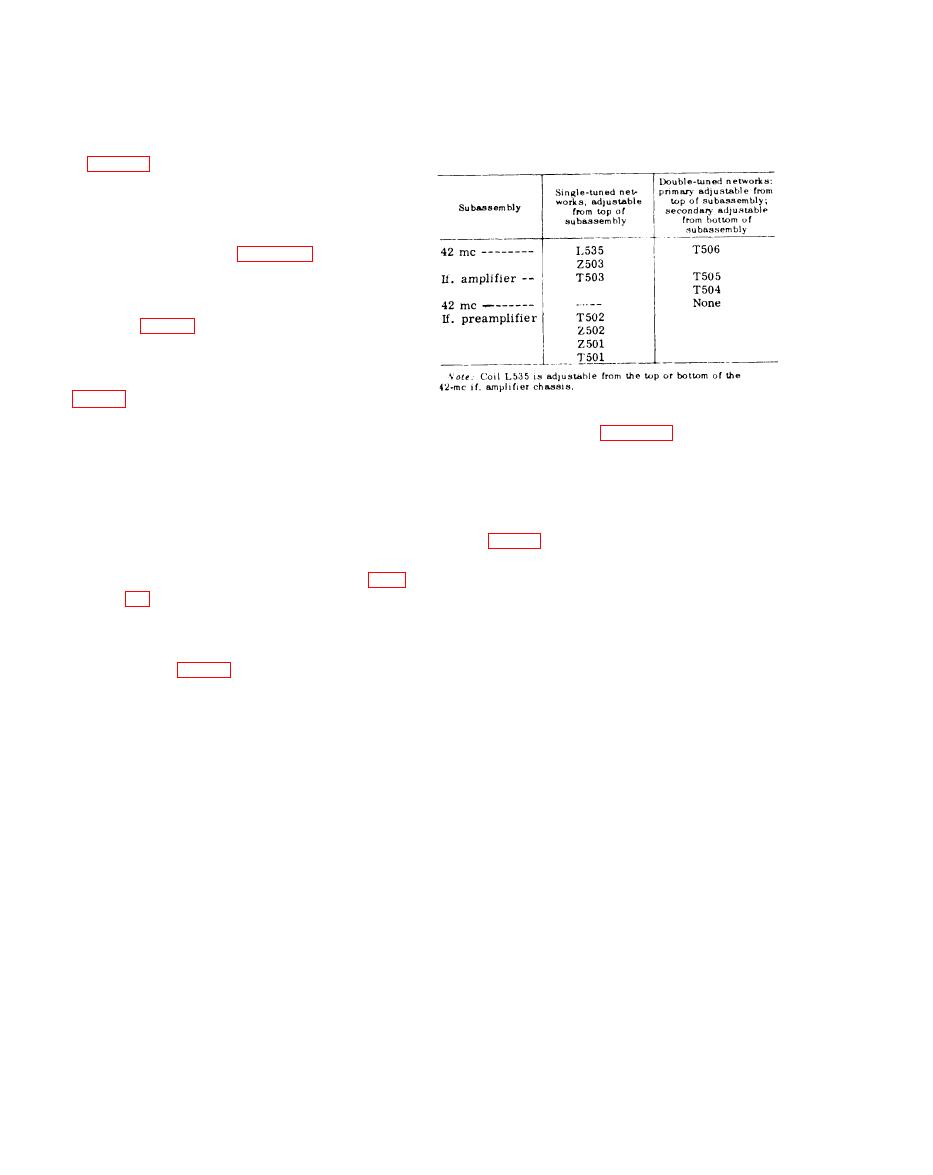 |
|||
|
|
|||
|
Page Title:
If. Amplifier Alignment, Tuning Unit 4, General |
|
||
| ||||||||||
|
|  plastic alignment tool with internal dimens-
95. If. Amplifier Alignment, Tuning
i o n s for fitting l/4-inch hexagonal nuts,
Unit 4, General
as was used for the previous tuning units.
a. The alignment of the tuning unit 4 if.
The following chart indicates the location
amplifier is similar to that of tuning unit
of the if. alignment adjustments.
3 (para 92). To align the 42-mc if. ampli-
f i e r subassembly (housing stages V508
through V512) and the 42-mc if. preampli-
f i e r subassembly (housing stages V505
through V507), remove the main unit from
i t s instrument case (para 40b, item 12,
T M 11-6625-351-12). Remove the dust
c o v e r from tuning unit 3. Interconnect
tuning unit 3 to the main unit with the test
harness (fig. 46).
b. Inject the unmodulated output of the
tuning unit 3 signal generator into the if.
preamplifier as indicated in the test setup
d.
Set the front-panel controls on the
(1) Connect one end of Cord CG-55B/U
test
set as listed in para 88c, except for
supplied with the tuning unit 3 sig-
the
FREQUENCY RANGE-MC switch; set
n a l generator into the generator
this
switch to the 400-700-mc position.
front-panel C A R R I E R OUTPUT
jack. This cord is terminated with
96. Alignment of 42-Mc If. Amplifiers,
a Radio Frequency Plug UG-
Tuning Unit 4
21B/U at each end.
(2) U s e the same cable assembly that
was fabricated for aligning the if.
amplifier of t u n i n g unit 2 (para
unit 3 signal generator to 42 mc and inject
89a(2) and (3)).
the unmodulated output signal into the if.
(3) Disconnect plug P509 (on the input
p r e a m p l i f i e r jack, J509. This jack is
cable assembly at the top of the if.
located on the electron tube side of the sub-
p r e a m p l i f i e r ) from its mating jack
assembly.
J509 (fig. 72).
Note: Do not confuse input jack J509 with input
(4) Connect the output of the tuning unit
jack J507, which is located at the end of the if.
p r e a m p l i f i e r adjacent to the gear train assembly.
3 signal generator, through the fab-
With the FREQUENCY RANGE-MC switch rotated
ricated cable assembly ((2) above),
to the 400-700-mc position m i c r o s w i t c h S502,
to jack J509 on the top of the if.
creates a path of continuity from inputjack J509 to
preamplifier.
if. transformer T501. Simultaneously, an open cir-
cuit exists at input jack J507 S o that the output of
Note: T h r o u g h o u t the following align-
only the 400-700-mc. tuner can be applied to the if.
ment procedure, d e c r e a s e the tuning unit
preamplifier circuit.
3 signal generator MICROVOLTS output
b. Set the MICROVOLTS control of the
control and the tuning unit GAIN control
s i g n a l generator to produce an approxi-
(if necessary) so that the main unit panel
meter maintains an onscale indication. Ini-
mate midscale indication on the main unit
tially set the tuning unit 3 signal genera-
p a n e l meter,
t o r MICROVOLTS control to a value of
c. The 42-mc if. amplifier is mounted
20K (equivalent to -20 dbm); then reduce
in a horizontal position at the top of the
the output setting as required, to keep the
p a n e l m e t e r i n d i c a t i o n lower than full
t u n i n g unit. W o r k i n g from the electron
seal e.
tube side of the 42-mc if. amplifier sub-
a s s e m b l y , adjust the cores of networks
c. As in tuning units 1, 2, and 3, the
Z503, T506, T505, T504, and T503, in this
cores of the tuned networks on the if. pre-
sequence, to obtain a maximum panel
amplifier and amplifier subassemblies are
m e t e r indication. A s the 42-mc unit is
provided with hexagonal nuts. Use the same
208
|
|
Privacy Statement - Press Release - Copyright Information. - Contact Us |